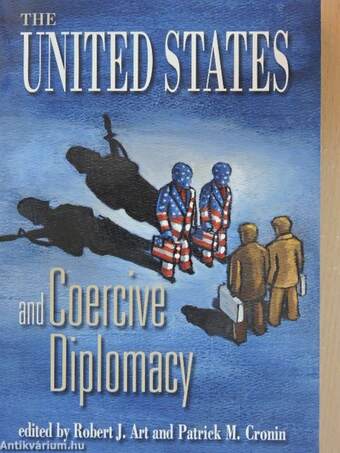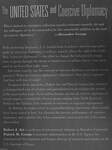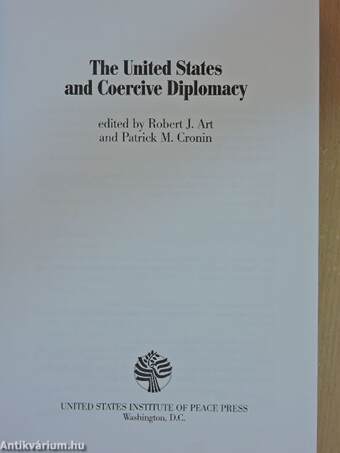1.067.732
kiadvánnyal nyújtjuk Magyarország legnagyobb antikvár könyv-kínálatát

VISSZA
A TETEJÉRE
JAVASLATOKÉszre-
vételek
The United States and Coercive Diplomacy
| Kiadó: | United States Institute of Peace Press |
|---|---|
| Kiadás helye: | Washington D. C. |
| Kiadás éve: | |
| Kötés típusa: | Ragasztott papírkötés |
| Oldalszám: | 442 oldal |
| Sorozatcím: | |
| Kötetszám: | |
| Nyelv: | Angol |
| Méret: | 23 cm x 15 cm |
| ISBN: | 1-929223-44-7 |
| Megjegyzés: | További szerzők a kötetben. |
naponta értesítjük a beérkező friss
kiadványokról
naponta értesítjük a beérkező friss
kiadványokról
Fülszöveg
"Tkis is indeed an exemplary collection of policy-relevant research. Art and his colleagues are to be commended for this remarkable addition to the work on coercive diplomacy." -Alexander George With increasing frequency, U.S. leaders look to achieve their foreign poiicy goals by marrying diplomacy to military musele. Since the end of the Cold War, "coercive diplomacy"-the effort to change the behavior of a target state or group through the threat or limited use of military force-has been used in no fewer than eight cases. But what, exactly, has the cöncept of coercive diplomacy meant in recent practice? What are coercive diplomacy's objectives? How does it operate? And how vvell does it work? To answer these questíóns, Róbert Art and Patrick Cronin have enlisted a distinguished Cast of scholars and practitioners to investigate the record of the past twelve years. Each author focuses on one of coercive diplomacy's recent targets, a remarkably diverse group ranging from North Korea... TovábbFülszöveg
"Tkis is indeed an exemplary collection of policy-relevant research. Art and his colleagues are to be commended for this remarkable addition to the work on coercive diplomacy." -Alexander George With increasing frequency, U.S. leaders look to achieve their foreign poiicy goals by marrying diplomacy to military musele. Since the end of the Cold War, "coercive diplomacy"-the effort to change the behavior of a target state or group through the threat or limited use of military force-has been used in no fewer than eight cases. But what, exactly, has the cöncept of coercive diplomacy meant in recent practice? What are coercive diplomacy's objectives? How does it operate? And how vvell does it work? To answer these questíóns, Róbert Art and Patrick Cronin have enlisted a distinguished Cast of scholars and practitioners to investigate the record of the past twelve years. Each author focuses on one of coercive diplomacy's recent targets, a remarkably diverse group ranging from North Korea to Serbia to the Taliban, from warlords to terrorisis to regipnal superpowers. As Róbert Art makes clear in a groundbreaking conclusion, those resülts have been mixed at best. Art dissects the uneven performance of coercive diplomacy and explains why it has sometimes worked and why it has more óften failed. Róbert J. Art is professor of international relations at Brandeis University. Patrick M. Cronin is assistant administrator at the U.S. Agency for International Development and former director of research and studies at the U.S. Institute of Peace. VisszaTémakörök
- Idegennyelv > Idegennyelvű könyvek > Angol > Történelem > USA története
- Történelem > Idegennyelvű > Angol
- Történelem > Politika > Külpolitika > Diplomácia
- Történelem > Kontinensek szerint > Amerika, amerikai országok története > Észak-Amerika
- Történelem > Legújabb kor > Globalizálódó világ
- Történelem > Hadtörténet > Hadügy, hadviselés
- Történelem > Tanulmányok
Megvásárolható példányok
Nincs megvásárolható példány
A könyv összes megrendelhető példánya elfogyott. Ha kívánja, előjegyezheti a könyvet, és amint a könyv egy újabb példánya elérhető lesz, értesítjük.








